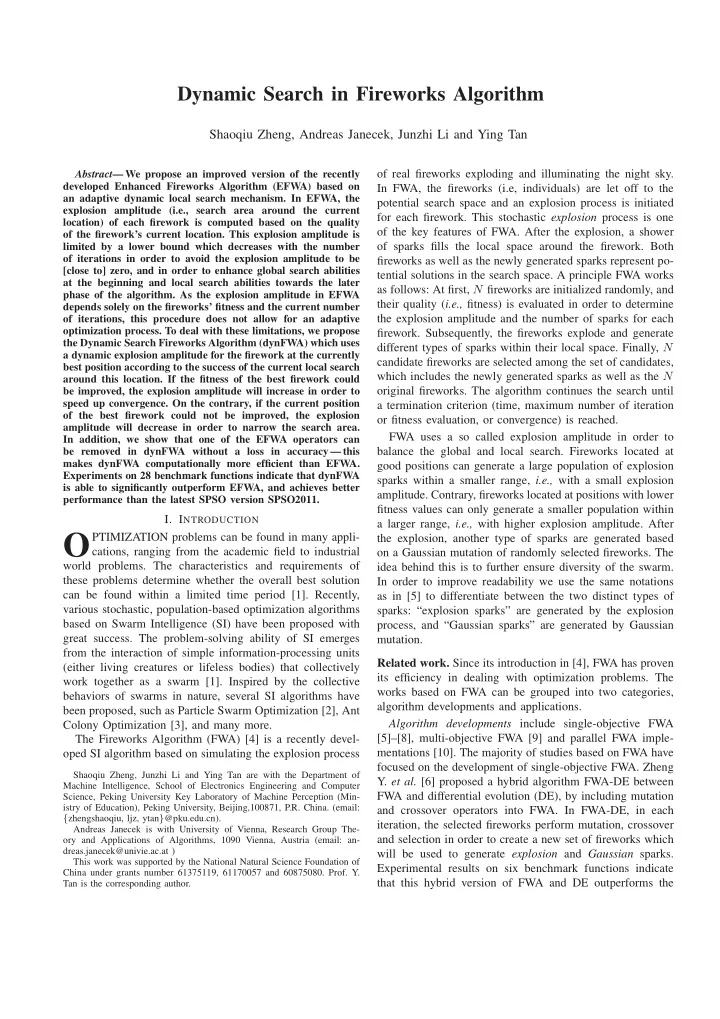

Dynamic Search in Fireworks Algorithm Shaoqiu Zheng, Andreas Janecek, Junzhi Li and Ying Tan of real fireworks exploding and illuminating the night sky. Abstract — We propose an improved version of the recently developed Enhanced Fireworks Algorithm (EFWA) based on In FWA, the fireworks (i.e, individuals) are let off to the an adaptive dynamic local search mechanism. In EFWA, the potential search space and an explosion process is initiated explosion amplitude (i.e., search area around the current for each firework. This stochastic explosion process is one location) of each firework is computed based on the quality of the key features of FWA. After the explosion, a shower of the firework’s current location. This explosion amplitude is of sparks fills the local space around the firework. Both limited by a lower bound which decreases with the number of iterations in order to avoid the explosion amplitude to be fireworks as well as the newly generated sparks represent po- [close to] zero, and in order to enhance global search abilities tential solutions in the search space. A principle FWA works at the beginning and local search abilities towards the later as follows: At first, 𝑂 fireworks are initialized randomly, and phase of the algorithm. As the explosion amplitude in EFWA their quality ( i.e., fitness) is evaluated in order to determine depends solely on the fireworks’ fitness and the current number the explosion amplitude and the number of sparks for each of iterations, this procedure does not allow for an adaptive optimization process. To deal with these limitations, we propose firework. Subsequently, the fireworks explode and generate the Dynamic Search Fireworks Algorithm (dynFWA) which uses different types of sparks within their local space. Finally, 𝑂 a dynamic explosion amplitude for the firework at the currently candidate fireworks are selected among the set of candidates, best position according to the success of the current local search which includes the newly generated sparks as well as the 𝑂 around this location. If the fitness of the best firework could be improved, the explosion amplitude will increase in order to original fireworks. The algorithm continues the search until speed up convergence. On the contrary, if the current position a termination criterion (time, maximum number of iteration of the best firework could not be improved, the explosion or fitness evaluation, or convergence) is reached. amplitude will decrease in order to narrow the search area. FWA uses a so called explosion amplitude in order to In addition, we show that one of the EFWA operators can be removed in dynFWA without a loss in accuracy — this balance the global and local search. Fireworks located at makes dynFWA computationally more efficient than EFWA. good positions can generate a large population of explosion Experiments on 28 benchmark functions indicate that dynFWA sparks within a smaller range, i.e., with a small explosion is able to significantly outperform EFWA, and achieves better amplitude. Contrary, fireworks located at positions with lower performance than the latest SPSO version SPSO2011. fitness values can only generate a smaller population within I. I NTRODUCTION a larger range, i.e., with higher explosion amplitude. After PTIMIZATION problems can be found in many appli- O the explosion, another type of sparks are generated based cations, ranging from the academic field to industrial on a Gaussian mutation of randomly selected fireworks. The world problems. The characteristics and requirements of idea behind this is to further ensure diversity of the swarm. these problems determine whether the overall best solution In order to improve readability we use the same notations can be found within a limited time period [1]. Recently, as in [5] to differentiate between the two distinct types of various stochastic, population-based optimization algorithms sparks: “explosion sparks” are generated by the explosion based on Swarm Intelligence (SI) have been proposed with process, and “Gaussian sparks” are generated by Gaussian great success. The problem-solving ability of SI emerges mutation. from the interaction of simple information-processing units Related work. Since its introduction in [4], FWA has proven (either living creatures or lifeless bodies) that collectively its efficiency in dealing with optimization problems. The work together as a swarm [1]. Inspired by the collective works based on FWA can be grouped into two categories, behaviors of swarms in nature, several SI algorithms have algorithm developments and applications. been proposed, such as Particle Swarm Optimization [2], Ant Algorithm developments include single-objective FWA Colony Optimization [3], and many more. The Fireworks Algorithm (FWA) [4] is a recently devel- [5]–[8], multi-objective FWA [9] and parallel FWA imple- oped SI algorithm based on simulating the explosion process mentations [10]. The majority of studies based on FWA have focused on the development of single-objective FWA. Zheng Shaoqiu Zheng, Junzhi Li and Ying Tan are with the Department of Y. et al. [6] proposed a hybrid algorithm FWA-DE between Machine Intelligence, School of Electronics Engineering and Computer FWA and differential evolution (DE), by including mutation Science, Peking University Key Laboratory of Machine Perception (Min- istry of Education), Peking University, Beijing,100871, P.R. China. (email: and crossover operators into FWA. In FWA-DE, in each { zhengshaoqiu, ljz, ytan } @pku.edu.cn). iteration, the selected fireworks perform mutation, crossover Andreas Janecek is with University of Vienna, Research Group The- and selection in order to create a new set of fireworks which ory and Applications of Algorithms, 1090 Vienna, Austria (email: an- dreas.janecek@univie.ac.at ) will be used to generate explosion and Gaussian sparks. This work was supported by the National Natural Science Foundation of Experimental results on six benchmark functions indicate China under grants number 61375119, 61170057 and 60875080. Prof. Y. that this hybrid version of FWA and DE outperforms the Tan is the corresponding author.
Recommend
More recommend